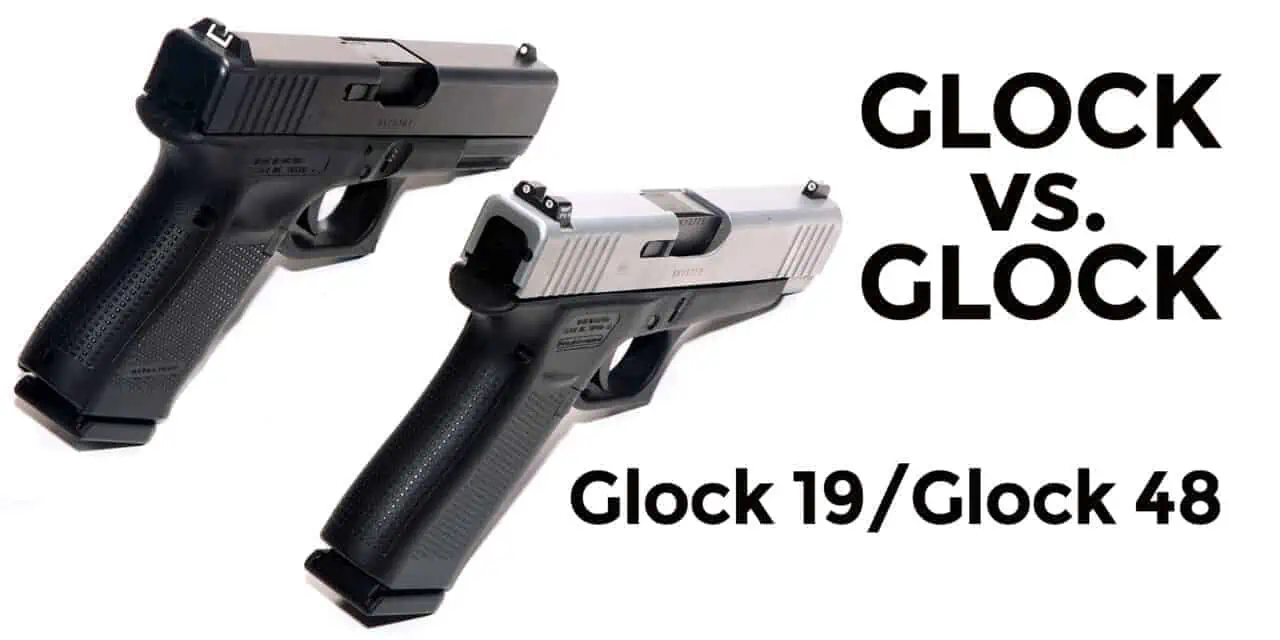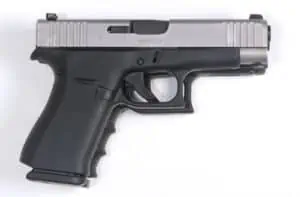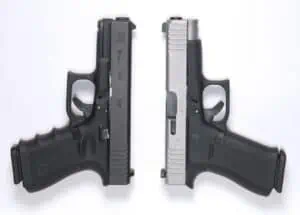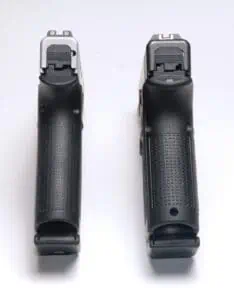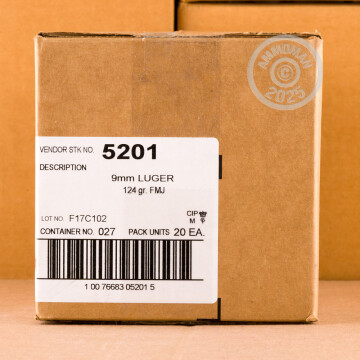Tested: Glock 48 vs Glock 19
In 1982, the Glock 17 reset all expectations about what a pistol was and what it could do. Lightweight, rugged and reliable, it touched off a revolution in pistol design that continues to this day. Glock chose to update and refine this basic formula in order to keep their designs fresh, rather than reinvent the wheel every time they came out with a new gun. As a result, keeping track of the features of one model of Glock over another can be a bit of a challenge. The fact that Glock names each new product in sequence of introduction and not by any features on the gun makes it even more confusing to sort out. To help with this, we’re going to do a short series of articles comparing different Glock models, starting with the Glock 48 vs the Glock 19.
Glock 48 vs 19 Fast Facts
- Both guns are very popular concealed pistols
- Glock 19 is thicker and holds more rounds. 48 is slimmer and lighter
- Both are very similar to shoot with many accessories available
Origin of the Glock 19
The Glock 19 was the second pistol introduced by Glock. It is chambered in 9mm Luger, just like the Glock 17 and Glock 18 before it. In essence, it is a slightly smaller and lighter version of the model 17. It has the same width as the model 17, but is not as tall and has a shorter barrel and slide. As a result, it holds 15 rounds in a double stack, standard capacity magazine versus the 17 rounds in a Glock 17 magazine.
Speaking of magazines, the longer, 17 round magazine for the Glock 17 will work in the Glock 19, as will even work in larger 33 round magazines that are common in the world of pistol caliber carbines. The 19 will also accept most sights and trigger upgrades for the model 17 as well. Be advised, though, that there are five generations of Glock 19 at the time this article was written, and internal components for one generation of Glock 19 may not work in another generation.
Origin of the Glock 48
One of the more subtle differences of the Glock 48 vs Glock 19 is how they came to be. The Glock 19 was a downsized version of a larger pistol. The Glock 48, on the other hand, is a larger version of a previous smaller pistol, the Glock 43. The 9mm Glock 43, in turn, is a slightly larger version of the Glock 42, chambered in .380 ACP.
The Glock 48 was a relative latecomer to the world of compact single stack 9mm pistols. Guns like the Smith & Wesson Shield and Ruger LC9 had been around for years before the Glock 48 came out. With 10 rounds of 9mm in the magazine and a flat, skinny profile, the Glock 48 has become a very popular choice for concealed carry in just a few years. There are quite a few accessories available for the Glock 48, including the Ameriglo sights on the gun in our photos.
At first glance, there are few differences between a Glock 48 vs a Glock 19. They are both about the same length, same height and have similar barrel lengths. Where things really matter is in the width of each gun, and how that affects their capacity and how easy they are to conceal.
Comparing the Glock 48 vs the Glock 19
We should begin by talking about what makes one pistol more easy to conceal than another pistol. There are four ways to describe the physical shape and size of a gun. The first is a pistol’s length, measured from the end of the muzzle to either the end of the grip or the end of the slide, whichever is greater. The second is the pistol’s height, measured from the bottom of the magazine to the top of the slide. The third is the pistol’s width. Last, is the weight of the pistol when fully loaded.
| Caliber | Weight (w/magazine) | Height (w magazine) | Width | Length | Barrel Length | Capacity | |
|---|---|---|---|---|---|---|---|
| Glock 48 | 9x19 Luger | 30.16 ounces | 5.04 inches | 1.10 inches | 7.28 inches | 4.17 inches | 10 rounds |
| Glock 19 | 9x19 Luger | 25.12 ounces | 5.04 inches | 1.26 inches | 7.36 inches | 4.02 inches | 15 rounds |
Some of those dimensions affect how easy a pistol is to conceal more than others. For instance, most of the length of a pistol is hidden by clothing, which has little effect on how easy it is to see if you have a gun or not. Height, however, matters a lot. It’s the butt of your gun that sticks out the most from your body, and that’s the portion that is usually the easiest to spot. Width is also important. A wider gun will bulge out more from your body and is harder to conceal. Finally, the weight of a pistol matters a lot. A heavier pistol will be less comfortable to carry for longer periods of time. It will also weigh down one side of your gun belt, which in turn might make your gun easier to spot under your clothing.
All of a sudden, those subtle differences between the Glock 48 vs the Glock 19 become a little more important. The Glock 48 is thinner and lighter, which will make it easier to carry and easier to conceal than a Glock 19. However, the Glock 48 only holds 10 rounds. There are magazine extensions out there which will boost the capacity of the Glock 48 to match the 15 round capacity of the Glock 19. However, those extensions add to the height of the gun, which in turn make it more difficult to conceal.
Practical Considerations
On the range, the two guns felt very similar to shoot and handled recoil in a similar way. The slimmer size of the Glock 48 vs a Glock 19 means that felt a little hard for me to control, but I chalk that up to having sent thousands of rounds downrange with a Glock 19. If you’re used to a Glock 48, I’m sure you’ll think it feels a little chunky in your hands.
Is the 10 rounds inside a Glock 48 vs a Glock 19’s 15 rounds that big of a deal? Good question. Using some of the best data that’s out there on how armed citizens perform in gunfights, we know that a pistol needs 3 rounds, on average, to stop a violent attacker. Therefore, in a best case scenario where you make all your shots, a Glock 48 is probably good against three attackers, while a Glock 19 might be able to handle up to five. Do you need 15 rounds rather than 10 rounds in your carry gun? I honestly don’t know. What I do know is that I’ve talked with a fair number of gunfight survivors, and not one has told me they had too many rounds of ammo on them when it happened.
Another thing to consider when trying to decide between a Glock 48 vs a Glock 19 is the amount of accessories available for each gun. Both of these guns are Glocks, which means they both benefit from Glock’s huge fan base. However, the Glock 19 has been around since 1988, and the Glock 48 was introduced in 2019. There are more accessories coming out for the 48 each day, but the Glock 19 does have quite the head start and is still a very popular personal defensive firearm.
Conclusions
Both the Glock 19 and Glock 48 fill very similar niches. The Glock 19, however, is descended from a full-sized service pistol and is in use by law enforcement agencies and militaries around the world. The Glock 48, on the other hand, was designed from the ground up with concealed carry in mind, and serves that role very well.
For the armed citizen, the question Glock 48 vs Glock 19 hinges on one decision. Is having five extra rounds with you at all times worth the effort of carrying a slightly heavier and thicker gun? The answer to that question, for me, was “Yes,” which is why I carry a Glock 19. For friends of mine, whoever, the answer was “No,” and they carry a Glock 48. Whichever gun you chose, it’s up to you to get the training and practice you need to live a safe and comfortable armed lifestyle. Do you have any thoughts on recoil management/shootability here? Seems like the 19 would be easier to get multiple hits on target. (Probably obvious to seasoned shooters since you mention size/weight but newer gun shoppers may not think about the implications and we need to spell it out.)

